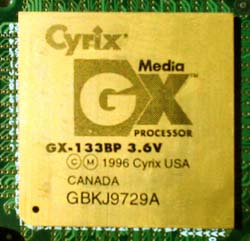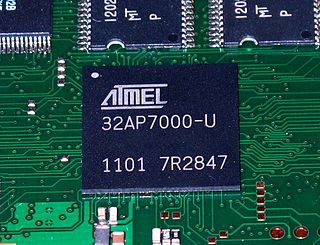Related Research Articles

Advanced Micro Devices, Inc. (AMD) is an American multinational semiconductor company based in Santa Clara, California, that develops computer processors and related technologies for business and consumer markets. While it initially manufactured its own processors, the company later outsourced its manufacturing, a practice known as going fabless, after GlobalFoundries was spun off in 2009. AMD's main products include microprocessors, motherboard chipsets, embedded processors, graphics processors, and FPGAs for servers, workstations, personal computers, and embedded system applications.

The StrongARM is a family of computer microprocessors developed by Digital Equipment Corporation and manufactured in the late 1990s which implemented the ARM v4 instruction set architecture. It was later acquired by Intel in 1997 from DEC's own Digital Semiconductor division as part of a settlement of a lawsuit between the two companies over plagiarism. Intel then continued to manufacture it before replacing it with the StrongARM-derived ARM-based follow-up architecture called XScale in the early 2000s.
SuperH is a 32-bit reduced instruction set computing (RISC) instruction set architecture (ISA) developed by Hitachi and currently produced by Renesas. It is implemented by microcontrollers and microprocessors for embedded systems.
XScale is a microarchitecture for central processing units initially designed by Intel implementing the ARM architecture instruction set. XScale comprises several distinct families: IXP, IXC, IOP, PXA and CE, with some later models designed as system-on-a-chip (SoC). Intel sold the PXA family to Marvell Technology Group in June 2006. Marvell then extended the brand to include processors with other microarchitectures, like ARM's Cortex.

The Athlon 64 is a ninth-generation, AMD64-architecture microprocessor produced by Advanced Micro Devices (AMD), released on September 23, 2003. It is the third processor to bear the name Athlon, and the immediate successor to the Athlon XP. The second processor to implement the AMD64 architecture and the first 64-bit processor targeted at the average consumer, it was AMD's primary consumer CPU, and primarily competed with Intel's Pentium 4, especially the Prescott and Cedar Mill core revisions. It is AMD's first K8, eighth-generation processor core for desktop and mobile computers. Despite being natively 64-bit, the AMD64 architecture is backward-compatible with 32-bit x86 instructions. Athlon 64s have been produced for Socket 754, Socket 939, Socket 940, and Socket AM2. The line was succeeded by the dual-core Athlon 64 X2 and Athlon X2 lines.

Intel's i960 was a RISC-based microprocessor design that became popular during the early 1990s as an embedded microcontroller. It became a best-selling CPU in that segment, along with the competing AMD 29000. In spite of its success, Intel stopped marketing the i960 in the late 1990s, as a result of a settlement with DEC whereby Intel received the rights to produce the StrongARM CPU. The processor continues to be used for a few military applications.

The Blackfin is a family of 16-/32-bit microprocessors developed, manufactured and marketed by Analog Devices. The processors have built-in, fixed-point digital signal processor (DSP) functionality supplied by 16-bit multiply–accumulates (MACs), accompanied on-chip by a microcontroller. It was designed for a unified low-power processor architecture that can run operating systems while simultaneously handling complex numeric tasks such as real-time H.264 video encoding.
LEON is a radiation-tolerant 32-bit central processing unit (CPU) microprocessor core that implements the SPARC V8 instruction set architecture (ISA) developed by Sun Microsystems. It was originally designed by the European Space Research and Technology Centre (ESTEC), part of the European Space Agency (ESA), without any involvement by Sun. Later versions have been designed by Gaisler Research, under a variety of owners. It is described in synthesizable VHSIC Hardware Description Language (VHDL). LEON has a dual license model: An GNU Lesser General Public License (LGPL) and GNU General Public License (GPL) free and open-source software (FOSS) license that can be used without licensing fee, or a proprietary license that can be purchased for integration in a proprietary product. The core is configurable through VHDL generics, and is used in system on a chip (SOC) designs both in research and commercial settings.

Geode was a series of x86-compatible system-on-a-chip microprocessors and I/O companions produced by AMD, targeted at the embedded computing market.

In computer engineering, microarchitecture, also called computer organization and sometimes abbreviated as µarch or uarch, is the way a given instruction set architecture (ISA) is implemented in a particular processor. A given ISA may be implemented with different microarchitectures; implementations may vary due to different goals of a given design or due to shifts in technology.
The PowerPC 400 family is a line of 32-bit embedded RISC processor cores based on the PowerPC or Power ISA instruction set architectures. The cores are designed to fit inside specialized applications ranging from system-on-a-chip (SoC) microcontrollers, network appliances, application-specific integrated circuits (ASICs) and field-programmable gate arrays (FPGAs) to set-top boxes, storage devices and supercomputers.

The MediaGX CPU is an x86-compatible processor that was designed by Cyrix and manufactured by National Semiconductor following the two companies' merger. It was introduced in 1997. The core is based on the integration of the Cyrix Cx5x86 CPU core with hardware to process video and audio output. Following the buyout of Cyrix by National Semiconductor and the sale of the Cyrix name and trademarks to VIA Technologies, the core was developed by National Semiconductor into the Geode line of processors, which was subsequently sold to Advanced Micro Devices.

The R3000 is a 32-bit RISC microprocessor chipset developed by MIPS Computer Systems that implemented the MIPS I instruction set architecture (ISA). Introduced in June 1988, it was the second MIPS implementation, succeeding the R2000 as the flagship MIPS microprocessor. It operated at 20, 25 and 33.33 MHz.

The R5000 is a 64-bit, bi-endian, superscalar, in-order execution 2-issue design microprocessor, that implements the MIPS IV instruction set architecture (ISA) developed by Quantum Effect Design (QED) in 1996. The project was funded by MIPS Technologies, Inc (MTI), also the licensor. MTI then licensed the design to Integrated Device Technology (IDT), NEC, NKK, and Toshiba. The R5000 succeeded the QED R4600 and R4700 as their flagship high-end embedded microprocessor. IDT marketed its version of the R5000 as the 79RV5000, NEC as VR5000, NKK as the NR5000, and Toshiba as the TX5000. The R5000 was sold to PMC-Sierra when the company acquired QED. Derivatives of the R5000 are still in production today for embedded systems.

AVR32 is a 32-bit RISC microcontroller architecture produced by Atmel. The microcontroller architecture was designed by a handful of people educated at the Norwegian University of Science and Technology, including lead designer Øyvind Strøm and CPU architect Erik Renno in Atmel's Norwegian design center.
LatticeMico32 is a 32-bit microprocessor reduced instruction set computer (RISC) soft core from Lattice Semiconductor optimized for field-programmable gate arrays (FPGAs). It uses a Harvard architecture, which means the instruction and data buses are separate. Bus arbitration logic can be used to combine the two buses, if desired.

RMI Corporation, formerly Raza Microelectronics, Inc., was a privately held fabless semiconductor company headquartered in Cupertino, California, which specialized in designing system-on-a-chip processors for computer networking and consumer media applications.
Since 1985, many processors implementing some version of the MIPS architecture have been designed and used widely.
References
- ↑ "About Alchemy Semiconductor". Archived from the original on 2014-11-07.
- 1 2 "Alchemy Semiconductor unveils Au1000 Internet Edge processor" (Press release). Embedded Processor Forum, San Jose, CA: Alchemy Semiconductor. 2000-06-13. Archived from the original on 2001-03-09.
- 1 2 Hoeppner, Greg (2000-06-13). Au1000 Internet Edge Processor - A High Performance / Low Power MIPS SOC. Embedded Processor Forum 2000. Alchemy Semiconductor. Archived from the original on 2000-09-18.
- ↑ "NetLogic Microsystems Announces Stockholder Approval Required for Acquisition of RMI Corporation" (Press release). NetLogic Microsystems. 2009-10-23. Archived from the original on 2010-03-30.
- ↑ "Chipmaker Broadcom to buy NetLogic for $3.7 billion". Reuters. 2016-09-12. Retrieved 2017-01-04.
- 1 2 Plummer, Suzanne (2000-08-13). The Au1000™ Internet Edge Processor: A High Performance, Low Power SOC. Hot Chips 12.
- 1 2 AMD Alchemy™ Au1000™ Processor Data Book (PDF). AMD. September 2005. Archived from the original (PDF) on 2006-10-15. Retrieved 2022-04-27.
- ↑ Bassett, Paul (2002-08-19). Alchemy Au1x00. Hot Chips 14.
- ↑ Eno, Jim (2005). White Paper: AMD Alchemy™ Au1200™ Processor System Architecture (PDF). AMD. Archived from the original (PDF) on 2005-12-23. Retrieved 2022-04-27.
- 1 2 Product Brief: RMI Alchemy™ Au1300™ Media Processor Series (PDF). RMI. December 2008.
- ↑ AMD Alchemy™ Au1000™ Processor Specification Update (PDF). June 2005.
- ↑ "Alchemy Semiconductor Expands Low Power, High Performance Chip Portfolio With Advent of Alchemy Au1500" (Press release). Embedded Processor Forum, San Jose, CA: Alchemy Semiconductor. 2001-06-11. Archived from the original on 2001-12-16.
- ↑ AMD Alchemy™ Au1500™ Processor Data Book (PDF). AMD. March 2006. Archived from the original (PDF) on 2006-10-15. Retrieved 2022-04-27.
- ↑ AMD Alchemy™ Au1500™ Processor Specification Update (PDF). June 2005.
- ↑ "Innovative Alchemy™ Au1100™ Processor From AMD Sets New Standard For Mobile Internet Appliance Market" (Press release). Sunnyvale, CA: AMD. 2002-04-08. Archived from the original on 2006-10-20.
- ↑ AMD Alchemy™ Au1100™ Processor Data Book (PDF). AMD. April 2006. Archived from the original (PDF) on 2006-10-20. Retrieved 2022-04-27.
- ↑ AMD Alchemy™ Au1100™ Processor Specification Update (PDF). June 2005.
- ↑ "AMD Introduces The AMD Alchemy™ Au1550™ Processor Delivering Integrated Secure Network Processing Power" (Press release). RSA Conference, San Francisco, CA: AMD. 2004-02-24. Archived from the original on 2006-05-28.
- ↑ AMD Alchemy™ Au1550™ Security Network Processor Data Book (PDF). AMD. May 2006. Archived from the original (PDF) on 2006-07-08. Retrieved 2022-04-27.
- ↑ "AMD Introduces the AMD Alchemy™ Au1200™ Processor, Forges New Era of Portable Multimedia" (Press release). Sunnyvale, CA: AMD. 2005-01-03. Archived from the original on 2006-03-15.
- ↑ AMD Alchemy™ Au1200™ Processor Data Book (PDF). AMD. February 2006. Archived from the original (PDF) on 2006-10-15. Retrieved 2022-04-27.
- 1 2 RMI Alchemy™ Au1210™ Navigation Processor and Au1250™ Media Processor Data Book (PDF). RMI. April 2007.
- ↑ "NetLogic Microsystems Low-Power Embedded Processors Solution and Product Selection Guide". NetLogic Microsystems. Archived from the original on 2010-12-13.
- ↑ "RMI Launches Alchemy Au1300 Processor Line" (Press release). 2009-01-13.